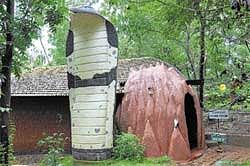

When we stepped out of the Mangalore Central Railway Station without an umbrella, it was obvious that we were tourists. While visitors crowded under a shelter, locals used their rain gear and walked out, unperturbed by the heavy downpour.
The unrelenting showers seemed to be a way of life here. Motorists clad in ankle length raincoats, school children holding umbrellas, auto rickshaws with tarpaulin covers — everyone seemed to have a way to work around the rain. It was business as usual. As we drove past rain drenched roads, water clogged paddy fields and houses with sloping clay tiled roofs we got a sense of what the monsoons are like in Mangalore.
From Mangalore City we headed to Pilikula Nisargadhama, a refreshing man made oasis in the concrete desert of urbanisation. In the local language Tulu, Pili means tiger and kula means pond. According to received wisdom, this area was once home to free roaming tigers that frequented a watering hole in the vicinity and hence the name.
Reviving ancient customs
If the legend is to be believed, then deforestation and destruction must have driven tigers out of their den and turned Pilikula into a barren land devoid of trees. However, a concerted effort by the Dakshina Kannada District Administration has brought the greens back to Pilikula and fostered its development as an eco-educational and tourism project.
Pilikula Nisargadhama is a commendable initiative to revive and showcase the ancient customs, traditions, heritage, flora and fauna of Dakshina Kannada. Spread across 370 acres, Pilikula Nisargadhama currently comprises of a biological park, an artisan village, a heritage village, a golf course, an amusement park, a science centre, a tourist home, a lake garden and an arboretum.
Since its inception in 2001, the Pilikula Biological Park has been doing its bit towards the conservation and breeding of flora and fauna endemic to the Western Ghats. Spread across 150 acres, this well maintained Biological Park shelters several species of birds and animals some of which are endangered.
The park currently has a snake house with many different snakes including king cobras, pythons, rat snakes, russell’s vipers and trinket snakes. Apart from 65 species of free ranging birds, there are animals like tigers, lions, leopards, mouse deer, sloth bears, crocodiles, porcupines, wild boars and elephants within enclosures that resemble their natural habitat. The park is soon going to have a King Cobra breeding centre commissioned by the Central Zoo Authority.
The Heritage Village comprising of coconut and areca plantations, a Kambala race track, a Guthu Mane and a Nagabana recreates the aesthetics of a rural setting in Dakshina Kannada. At the heart of the village stands a replica of a typical Guthu Mane (the traditional house of the coastal landlords) resplendent with carved pillars and ceilings. Kambala is an age old folk sport of buffalo racing.
The Nethravathi-Phalguni race track constructed in front of the Guthu Mane plays host to the annual Jodekare Kambala event. Nagabana is the serpent shrine in the vicinity of the Guthu Mane where the snake God is worshiped.
The artisan village is an interesting concept where master craftsmen reside in houses dedicated to a particular traditional art. Apart from training those who are interested in acquiring a particular skill the artisans make products which are marketed by the Pilikula Nisargadhama Society. Weaving, black smithy, pottery making, cane and bamboo works, making beaten rice, wood and stone carving and oil extraction are some skills demonstrated by the artisans.Visitors can watch the artisans at work and also interact with them. The Artisan Village is an effort to preserve and promote the age old vocations of the people of Dakshina Kannada.
Biodiversity hotspots
Perched atop a hillock overlooking the quiet flowing Gurupura River, coconut groves and acacia plantations is the Gurupura Nisargadhama Resort. The resort is the latest offering of Jungle Lodges and Resorts, a government of Karnataka undertaking. The property offers scintillating views of the prosperous river bank and hills looming over the lush green plains. Day trippers can stop by at the resort for a sumptuous meal with Mangalorean delicacies.
The Western Ghats are recognised as one of the biodiversity hot spots in the world is home to several rare plants. With over 60,000 saplings, the arboretum in Pilikula is a treasure trove of flora, many of which are endemic to the Western Ghats. Visitors can walk along the 3 km long pathway to get a closer look at the varieties of trees and shrubs.
The peaceful Pilikula Lake and its surrounding gardens attract a large number of visitors. Desilting and restoration efforts have been undertaken to breathe life into the lake. Fresh water fish, ducks and geese have been introduced into the lake. Motor boats and pedal boats are available at the boating point. Cutting across lush lawns and landscaped gardens around the lake are jogging tracks and walking paths.
Among other things Pilikula stands out as a human effort to give a reprieve to nature. The initiative of the Pilikula Nisargadhama Society to showcase the rich cultural heritage and natural wealth of Dakshina Kannada district is commendable. Be it just a quick visit to this green paradise or a holiday to unwind in the nature’s lap, Pilikula is great place to acquaint with nature and understand the importance of saving it for another day.